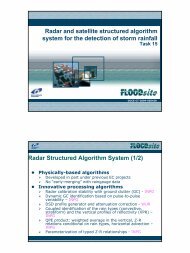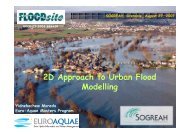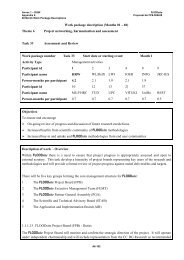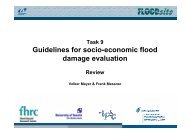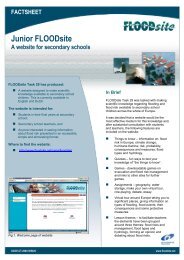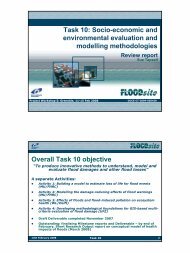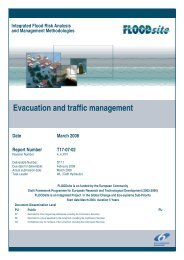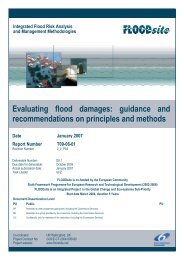Language of Risk - FLOODsite
Language of Risk - FLOODsite
Language of Risk - FLOODsite
You also want an ePaper? Increase the reach of your titles
YUMPU automatically turns print PDFs into web optimized ePapers that Google loves.
<strong>FLOODsite</strong> <strong>Language</strong> <strong>of</strong> <strong>Risk</strong> 2 nd Ed.<br />
Contract No:GOCE-CT-2004-505420<br />
Natural variability - Uncertainties that stem from the assumed inherent randomness and basic<br />
unpredictability in the natural world and are characterised by the variability in known or observable<br />
populations.<br />
Parameters - The parameters in a model are the “constants”, chosen to represent the chosen context<br />
and scenario. In general the following types <strong>of</strong> parameters can be recognised:<br />
Exact parameters - which are universal constants, such as the mathematical constant: Pi (3.14259...).<br />
Fixed parameters - which are well determined by experiment and may be considered exact, such as<br />
the acceleration <strong>of</strong> gravity, g (approximately 9.81 m/s).<br />
A-priori chosen parameters - which are parameters that may be difficult to identify by calibration and<br />
so are assigned certain values. However, the values <strong>of</strong> such parameters are associated with uncertainty<br />
that must be estimated on the basis <strong>of</strong> a-priori experience, for example detailed experimental or field<br />
measurements<br />
Calibration parameters - which must be established to represent particular circumstances. They must<br />
be determined by calibration <strong>of</strong> model results for historical data on both input and outcome. The<br />
parameters are generally chosen to minimise the difference between model outcomes and measured<br />
data on the same outcomes. It is unlikely that the set <strong>of</strong> parameters required to achieve a "satisfactory"<br />
calibration is unique.<br />
Pathway – Route that a hazard takes to reach Receptors. A pathway must exist for a Hazard to be<br />
realised.<br />
Performance - The degree to which a process or activity succeeds when evaluated against some stated<br />
aim or objective.<br />
Performance indicator - The well-articulated and measurable objectives <strong>of</strong> a particular project or<br />
policy. These may be detailed engineering performance indicators, such as acceptable wave<br />
overtopping rates, rock stability, or conveyance capacity or more generic indicators such as public<br />
satisfaction.<br />
Post-flood mitigation - Measures and instruments after flood events to remedy flood damages and to<br />
avoid further damages.<br />
Precautionary Principle - Where there are threats <strong>of</strong> serious or irreversible damage, lack <strong>of</strong> full<br />
scientific certainty shall not be used as a reason for postponing cost-effective measures to prevent<br />
environmental degradation.<br />
Precision — degree <strong>of</strong> exactness regardless <strong>of</strong> accuracy.<br />
Pre-flood mitigation - Measures and instruments in advance to a flood event to provide prevention<br />
(reducing flood hazards and flood risks by e.g. planning) and preparedness (enhancing organisational<br />
coping capacities).<br />
Preparedness – The ability to ensure effective response to the impact <strong>of</strong> hazards, including the<br />
issuance <strong>of</strong> timely and effective early warnings and the temporary evacuation <strong>of</strong> people and property<br />
from threatened locations.<br />
Preparedness Strategy - Within the context <strong>of</strong> flood risk management a preparedness strategy aims at<br />
ensuring effective responses to the impact <strong>of</strong> hazards, including timely and effective early warnings<br />
and the evacuation <strong>of</strong> people and property from threatened locations.<br />
T32_04_01_ <strong>FLOODsite</strong>_<strong>Language</strong>_<strong>of</strong>_<strong>Risk</strong>_D32_2_v5_2_P1 30 April 2009<br />
30



